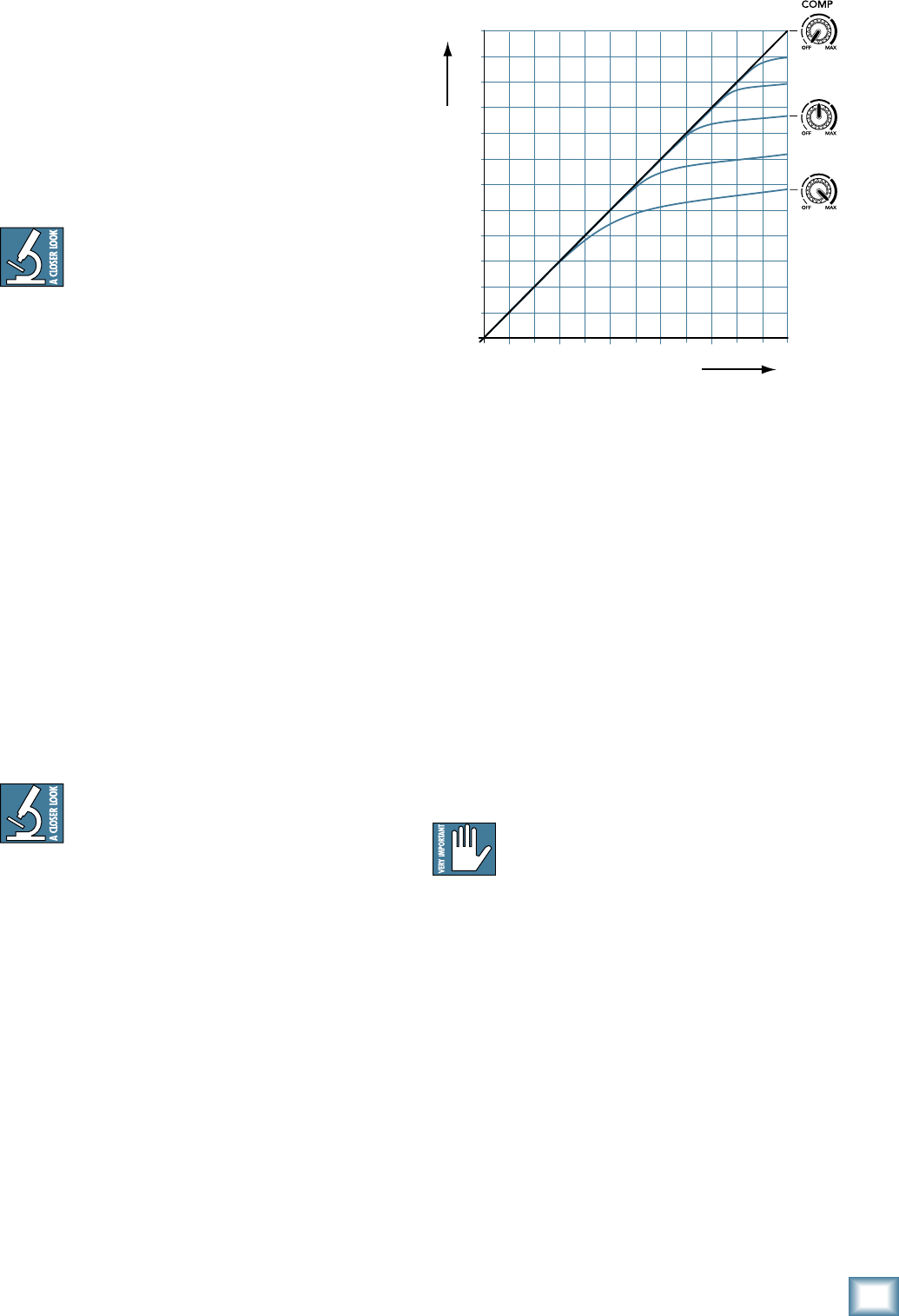
19
Owner’s Manual
Owner’s Manual
29. COMPRESSOR
Channels 1 to 4 have an in-line compressor circuit
with a variable threshold. This is very useful for com-
pression of vocals, for example.
When the incoming signals exceed the threshold level
set by this knob, the signal level is automatically com-
pressed. This reduces the dynamic range, and reduces
the chance of distortion due to overloading the input
signals.
Dynamic range is the difference in level be-
tween the quietest part of your song and the
loudest part. Using a compressor, you are able
to squeeze the dynamic range, resulting in
an overall steadier, more constant volume level for the
signal. It helps sources such as vocals "sit" properly in
the mix, and it is very useful for live sound as well.
The compression ratio is fixed at around 6:1, with
a soft knee response. The threshold can be adjusted
clockwise from off (no compression) to 0 dBu (max).
As an example, suppose the threshold is set to maxi-
mum. An incoming signal reaches the threshold of 0
dBu. As it increases beyond the threshold, it becomes
compressed at a ratio of 6:1. This means that even if the
input further increases by 6 dB, the actual output only
increases by 1 dB. This compresses the output signal, so
there is more protection to your system from distortion
and overload due to poor microphone technique (say
it ain't so) and general pops, bangs and heavy metal
screaming. The soft knee means that the compression
slowly ramps up to 6:1 from the threshold. It does not
jump abruptly to 6:1, as this would be hard knee com-
pression, and hard on the ears too.
The following graph shows the input signal
level going into the compressor, versus the
output level coming out of it. It is the typical
graph to see when compressors are discussed,
and is just the kind of thing our engineers like to talk
about during the company Christmas party.
If the compressor is off, then the input = output. For
example an input signal level of +5 dBu results in an
output level of +5 dBu. The diagonal line from lower left
to upper right represents x = y, that is, input = output.
At the maximum compression, the threshold is set
at 0 dBu, and the input to output relationship is repre-
sented by the lower blue curve. If the input is –5 dBu
(that is, below this threshold), the output is –5. As the
input reaches 0 dBu, the output is a bit less than 0 dBu.
If the input is +5 dBu, the output is about +2 dBu. If
the input reaches +10 dBu, then the output is +3 dBu.
Notice the shapely curve of the soft knee between the
diagonal slope of x = y and the compressor slope of 6:1
(the compression ratio).
+20
-10
-5
+0
+5
+10
+15
+20-10 -5 +0
SLOP
E
6:
1
SO
F
T
K
NE
E
SL
O
PE 1:1
+5 +10 +15
INPUT SIGNAL STRENGTH dBu
OUTPUT SIGNAL STRENGTH dBu
The other blue curves represent in-between positions
of the compressor knob, with higher thresholds before
compression begins.
Separate compressors often have controls such as
compression ratio, threshold, soft knee/hard knee, at-
tack time, and release time. These last two affect how
quickly the compressor kicks in when the input exceeds
the threshold, and how quickly it is released after it
drops below the threshold. In this powered mixer com-
pressor, these parameters are specially chosen to give
you the best overall performance.
Adjust the threshold carefully, so your dynamic range
is still lovely, without distortion or overload during the
performance. Run through a few practice songs and
adjust the compression as required.
30. HI-Z SWITCH
Channels 5 and 6 are the only place to plug
in guitars and basses directly to the powered
mixer. These switches must be pressed in first.
If you connect a line-level device, such as a keyboard
or drum machine, make sure these switches are out.
(They only affect the 1/4" line inputs of channels 5 or 6,
not the XLR mic inputs.)
To use guitars or other instruments on other chan-
nels, you will need to use an external DI box first. With-
out the DI box, (or if these switches are not pressed in)
guitars will sound dull and muddy.


















